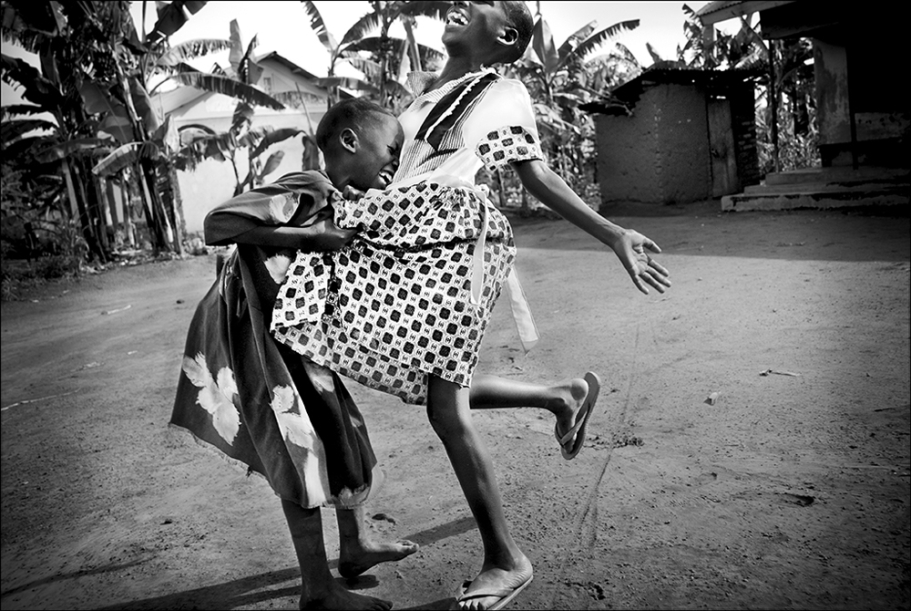
A Moment in the Glass: The Secret Life of Uganda's Daughters
Photographer: Leslie Alsheimer
Exhibit Title: A Moment in the Glass: The Secret Life of Uganda's Daughters
Location: Uganda
It is her light, it is the curl in the corners of her mouth, it is the sparkle in her eyes, and it is her unedited and untainted laughter. She is the child that does not yet understand the meaning of poverty. She is the child that has not yet seen the violence and destruction so prevalent in the world. She is the child that lost her mother to AIDS, disease, war, famine or child birthing complications, yet remains joyous and youthful despite the suffering.
She is the mother that lost her child or husband, but goes on with admirable strength to care for her family. The woman who breaks barriers in hopes of an education, or the woman that walks for miles just to get a simple check up. The light, the strength, the hope and the dignity.
Dignity: The quality or state of being worthy of esteem or respect. Nobility of character, manner or language. - Anika Amon
Uganda is a land of contradiction. Overwhelming sorrow and immense joy exist side by side. In the wake of 30,000 child soldier abductions, 26 years of the LRA and Joseph Kony's mindless slaughter, and with malaria and HIV/AIDS pandemics ravaging communities already haunted by the specter of dictatorship, genocide, and war —Ugandans embody an irrepressible spirit of optimism, courage, and love.
We live in a news culture that presents the most traumatic and tragic sound bites of world events, showing us the pain and suffering of one catastrophic event after another. While the recent Kony 2012 video has brought a wave of attention to Uganda, subsequent headlines have often failed to adequately represent the inspirational resilience and beauty of its survivors. "A Moment in the Glass: The Secret Life of Uganda's Daughters" challenges the common depictions of Africa, particularly African women, by telling the visual story of women and girls in post-conflict Uganda. Resilient women of hope and determination who are working to create peaceful communities where they and their families are free from all forms of violence.
Depictions of Africa are often reduced to the presentation of a bleeding or scarred war casualty, limbless amputee, starving child, or naked rape victim. Entire nations are frequently cast as helpless, passively waiting for charity and impending death without doing anything for themselves. Although necessary and powerful representations at times, the collective unbalanced, negative imagery of the developing world has desensitized many of us to the problems they face and further, has the power to reinforce patronizing attitudes of race, gender and culture that can marginalize people of color.
Uganda, like most of Africa, is far more complex, engaging, and vibrant than the images the popular media would have us believe. And Ugandan women, often considered the invisible backbone of their society, are emerging from the cultural shadows and reclaiming the fundamental rights of their families to exist, grow and thrive in a land that is struggling to maintain fragile pockets of peace in the midst of poverty and devastation.
A home: a place to rest, to eat and to be. The dirt floor, the crowded rooms, the lantern, and the outhouse do not detract from the fact that a home is a home. Over 1.4 billion people live in extreme poverty around the world. They live without the thought or idea of the luxuries experienced in the developed world. Yet these Ugandan faces tell another tale. Their faces show life and celebration through the joy, pain, and love of everyday living.
Poverty is visible for all to see, but what is often more difficult is seeing individuals — the dignity, beauty splendor and hope that can be found in the human spirit — regardless of circumstance. I try to convey that dignity and spirit of individuals and communities who are often misunderstood, negatively represented, or simply not represented in the traditional visual vocabulary.
We live in a news culture that presents the most tragic sound bites of world events, from one catastrophe to the next. Although necessary and powerful representations at times, the collective unbalanced negative imagery of the developing world has desensitized many of us to the problems they face.
Poverty is visible for all to see, but what is often more difficult is seeing individuals — the dignity, beauty splendor and hope that can be found in the human spirit — regardless of circumstance.
I try to convey that dignity and spirit of individuals and communities who are often misunderstood, negatively represented, or simply not represented in the traditional visual vocabulary.
Leslie Alsheimer Photography
www.lesliealsheimer.com
leslie@lesliealsheimer.com
505-670-9898
mailing address:
1000 Cordova Place Suite 155
Santa Fe, NM 87505
Make Comment/View Comments